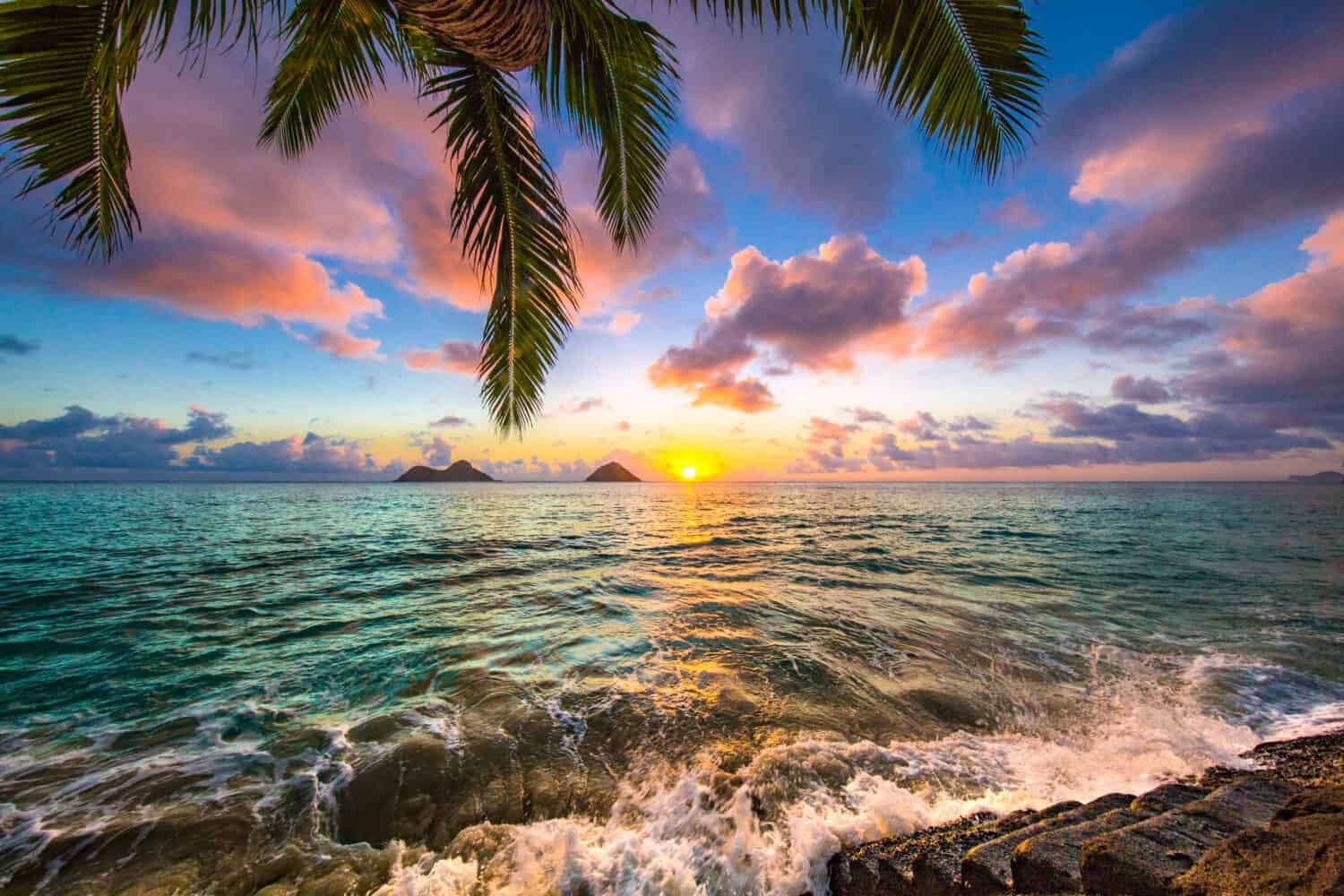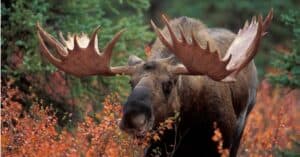Hawaii may welcome around 10 million visitors every year, but only 1.4 million people call the Aloha State home. Made up of 137 islands surrounded by the largest ocean on the planet, only seven Hawaiian Islands are inhabited. The tropical island chain has even fewer counties. Out of the state’s five counties, residents are fleeing the two fastest-shrinking counties in Hawaii.
Hawaii
Geography
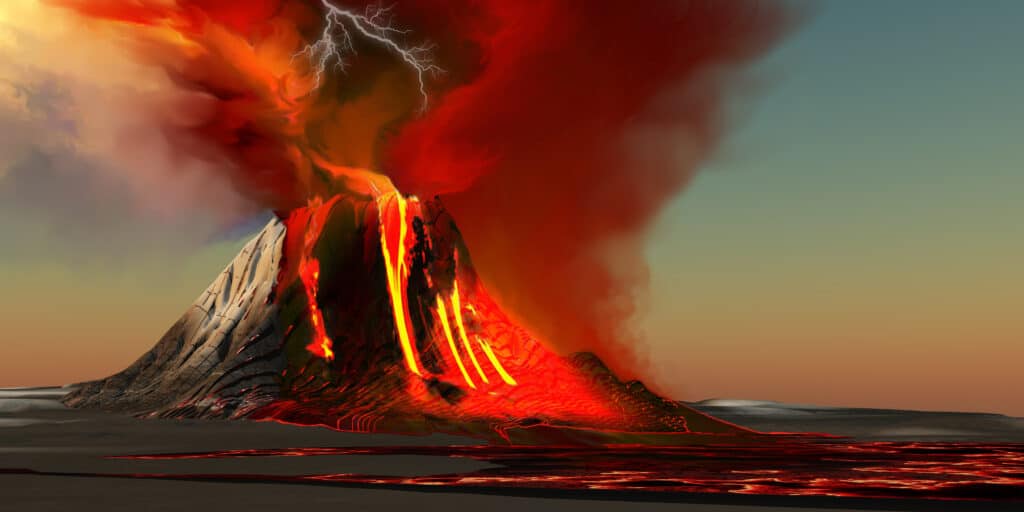
The Hawaiian Islands are still affected by lava flow, although experts do not believe it contributes to why residents are fleeing Hawaii’s fastest-shrinking counties.
©Catmando/Shutterstock.com
The Aloha State is a unique jewel in the United States. The only state located in the tropics, it’s also the only one outside North America and the country’s lone archipelago. Hawaii sits about 2,000 miles off the western coast of the United States in the Pacific Ocean. Its capital, Honolulu, is located on the island of Oahu.
The entire chain of Hawaiian Islands was formed by a volcanic hot spot. As the Pacific Plate — the tectonic plate below the island chain — moves over a plume of magma puncturing Earth’s crust, the molten rock hardens on the surface to create land. Hawaii’s islands form a chain running to the northwest because that is the direction the plate moves at a rate of roughly 2.75 inches a year.
Kauai, the oldest of the islands, doesn’t have any active volcanoes because it is the oldest of the six largest Hawaiian Islands — the Big Island, Maui, Lanai, Molokai, Oahu, and Kauai. Rather than growing in size from upwelling molten rock, Kauai is subject to its opposite geological force, erosion. This process has sculpted the island’s landscapes into its signature, scenic cliffs.
Demographics
The total area of the Hawaiian Islands is 10,932 square miles. It is the eighth smallest in land area and the 43rd-most populous of all 50 states, according to Wisevoter. Its population of 1.4 million, however, means Hawaii ranks 12th in population density in the country. There are 231 people per square mile living on the state’s various tropical islands.
New Jersey, for comparison, has the country’s highest population density at 1,283 people per square mile. The Garden State, as it’s often called, has a population more than double that of Hawaii. The state, slightly larger than Hawaii with 8,723 square miles, is home to 9.2 million people.
History
After emerging from the sea starting 5.1 million years ago, the barren lava deserts were colonized by plants hitching a ride in the breeze or on ocean currents from surrounding continents and distant lands. Animals had to be able to either fly or swim to reach the virgin lands. Since the volcanic islands were never connected to any continent, the only mammals native to Hawaii are a bat (Hawaiian hoary bat) and seal (Hawaiian monk seal) species. There were no species of reptiles, amphibians, or conifers on any Aloha State island before the arrival of human beings.
The first human residents of the islands had to take one of the same routes as the plants and animals, over the water. Polynesians from the area of the Marquesas Islands, coming from a tradition of Pacific voyaging expertise and canoe making, settled the Hawaiian islands between 1000-1200 AD.
British explorer and navigator, James Cook, made the first European discovery of Hawaii when he landed on Kauai on January 20, 1778. He was killed during a fight with several Hawaiians at Kealakekua Bay when he returned the following year.
Almost a hundred years later, the United States annexed Hawaii in 1898. Another 61 years after that, Hawaii became the 50th state in the country after a popular vote on August 21, 1959.
Before becoming an official state, on December 7, 1941, the Japanese launched a surprise attack on Pearl Harbor on the island of Oahu during World War II. The memorial to those who lost their lives during that attack continues to be a popular tourist attraction on the island. The USS Arizona Memorial draws more than 1.7 million visitors each year from around the world.
Hawaiian Islands
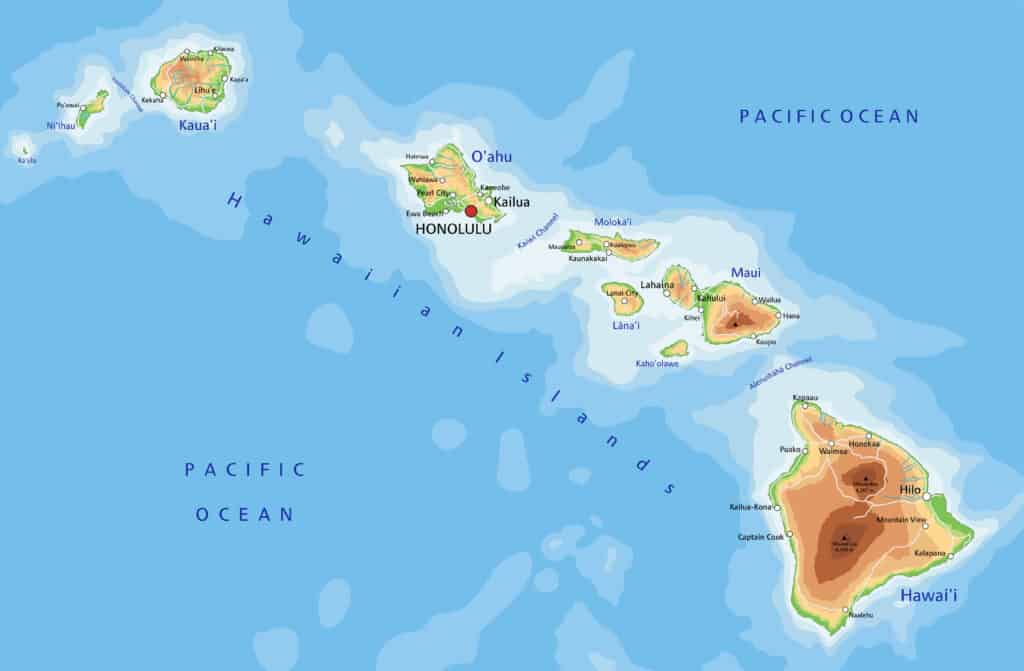
Only seven of Hawaii’s 137 islands are inhabited and five of those are part of the fastest-shrinking counties.
©Bardocz Peter/Shutterstock.com
While seven of the 137 volcanic islands that make up the state of Hawaii are inhabited, only six allow visitors. The inhabited islands are the Big Island, Maui, Molokai, Lanai, Oahu, Kauai, and Niihau.
Oahu
Oahu gets the most visitors of all the islands, with nearly 4.7 million tourists annually. Famous for its state capital of Honolulu, as well as Pearl Harbor and the iconic beach known as Waikiki, Oahu is known as the Heart of Hawaii.
Sometimes called “The Gathering Place,” the third largest Hawaiian island is home to the vast majority of the state’s population. According to U.S. Census data, 995,638 people live on the island. Oahu’s capital city Honolulu holds the majority of Oahu’s population with an estimated 350,399. The next largest city on the island is Pearl City, which is home to 47,698 residents.
The Big Island of Hawaii
Although the Big Island is the state’s largest island physically at more than 4,000 square miles, it comes in second after Oahu for population size. Its 186,738 residents give it a population density of less than 50 people per square mile.
Four of Hawaii’s five main active volcanoes are located on the Big Island. Kilauea, Mauna Loa, Mauna Kea, and Hualapai. While lava flows from these volcanoes do endanger residents’ property and livelihoods, they seldom endanger their lives.
Maui
“The Valley Isle,” Maui’s nickname, is the second largest of Hawaii’s islands. It is home to the third-largest population of 144,444 people. Thanks to its 120 miles of coastline and more than 30 miles of world-famous beaches, Maui welcomes around a million tourists every year.
Kauai
The fourth largest of Hawaii’s islands is also called the “Garden Island.” It is the northernmost and oldest of the archipelago, which means it has had the most time to develop its lush overgrowth of tropical rainforests, forking rivers, and cascading waterfalls. It boasts a population less than half that of Maui with fewer than 67,000 people calling the Garden Island home. Word of its beauty, however, motivates more than 1.3 million visitors to enjoy the island’s tropical paradise each year.
Molokai and Lanai
Molokai, or the “Friendly Island” because of its reputation of welcoming visitors, has a population of 7,345. Lanai’s population is slightly smaller at 3,135 residents. It is known as the “Pineapple Island” because for many years most of its 141 square miles were devoted to growing pineapples.
Niihau
Niihau Island may have the most interesting modern history of all of Hawaii’s archipelago. It is known as the “Forbidden Island” because tourists are forbidden. Privately owned by the Robinson Family, who ran a ranch on the island until 1999, they enacted a closed-door policy more than 150 years ago to create a cultural preservation site for native Hawaiians.
The Forbidden Island is the last place in Hawaii where the native language is still spoken fluently as the predominant language. The island has no plumbing, running water, paved roads, telephone service, police or fire department, doctors, or cars. It has no electrical grid, although the residents started using solar power to power their homes and the island’s school.
According to the U.S. Census Bureau, there are 84 residents of the Forbidden Island, although a recent informal population count indicated the number of people living on the island for any meaningful amount of time was much lower. Niihauheritage.org reports that there are no more than 70 residents living on the island during the school year and that number drops to less than 30 during the summer months. The site points to a lack of employment opportunities as the major reason for the island’s dwindling population.
Hawaii’s Population Decline
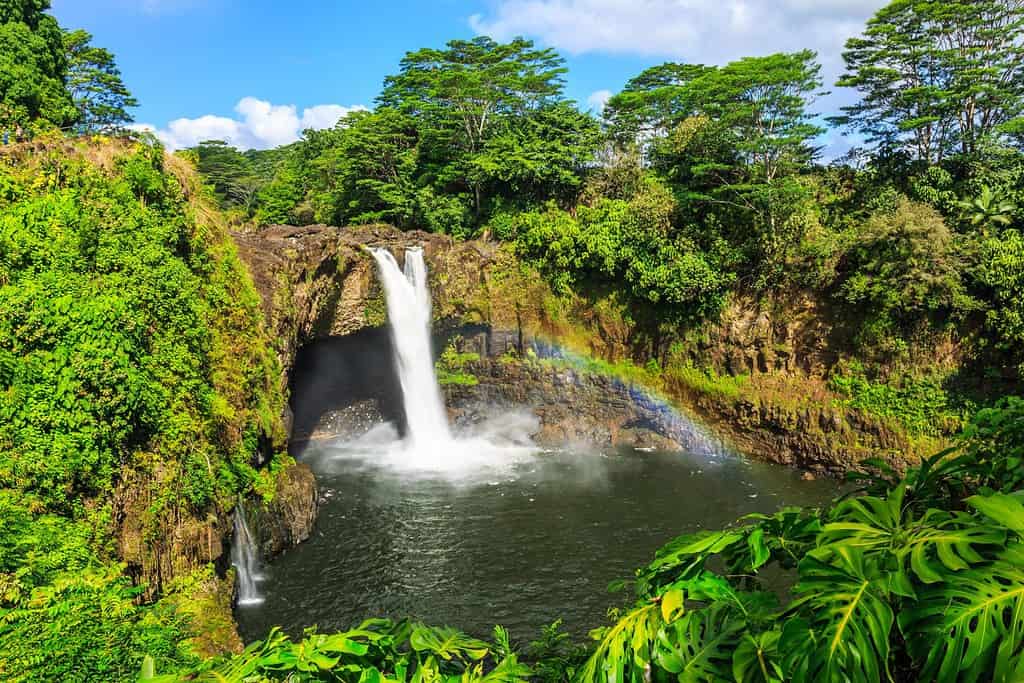
Hawaii’s eight main islands are dotted with more than 100 documented waterfalls.
©SCStock/Shutterstock.com
Niihau is not the only place in Hawaii experiencing a decline in population. As a whole, the Aloha State is experiencing the fifth-highest population decline in the nation. According to KITV4, Hawaii’s chief economist said Hawaii’s population has decreased for the past seven years with 15,000 people moving away in 2022 alone.
On average, almost 20 people left the state every day that year. KITV4 reports that the top five states Hawaiians are moving to are California with almost 12,000 making the transition in 2022. Following California, residents relocated to Texas, Washington state, Arizona, and Florida.
In the previous year, from July 1, 2020, to July 1, 2021, Hawaii’s population declined by 10,358 residents. There was a 0.48 percent decline from 2021-2022 and a 0.27 percent decline from 2020-2021.
Residents Are Fleeing These 2 Fastest-Shrinking Counties
While Hawaii overall is seeing a population decline, certain counties are being hit the hardest with outmigration. The U.S. Census Bureau aggregates information for Hawaii’s five counties, Honolulu, Kalawao, Kauai, and Maui, although the county of Kalawao is often omitted from the data.
Kalawao
Kalawao County is the smallest county in the country by land area and the second smallest by population. It is situated on a peninsula on the north coast of the island of Molokai. Because of its small size, it is a judicial district of Maui County and has no elected government.
The county’s 82 residents lack a local government and are instead administered by the Hawaii Department of Health because of its history of being the quarantine site of previous and current leprosy patients. Hawaii.gov does not list Kalawao as one of its counties on its website. While it has at times been Hawaii’s fastest-shrinking county in terms of percentage, it would not be considered to affect the state as a whole.
2. Maui County, HI
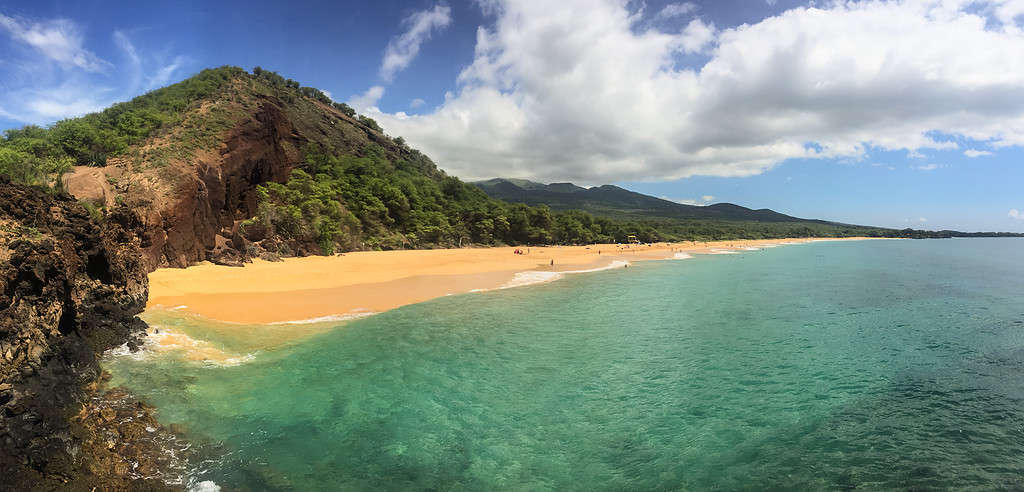
Despite its world-famous beaches, Maui County is one of the state’s fastest-shrinking counties.
The County of Maui consists of the inhabited islands of Maui, Molokai, and Lanai, and the uninhabited island of Kahoolawe. It is the second largest of Hawaii’s four other counties excluding Kalawao.
According to U.S. Census data, the county’s population dropped 0.2 percent in the years from 2020, when the last census was administered, 2022. The Grassroots Institute of Hawaii reports that surveys show that the state’s high cost of living is the main reason people are moving.
In 2020, Maui County had 164,842 residents. That number dropped to 164,840 in 2021 and further declined to 164,433 in 2022.
1. Honolulu County, HI
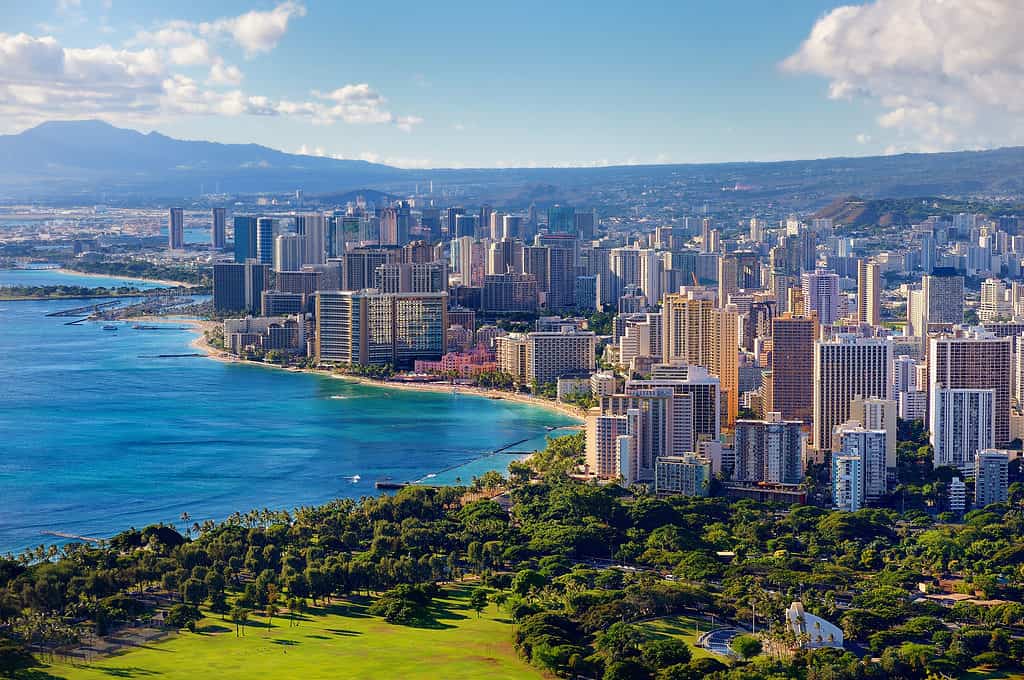
Hawaii’s fastest-shrinking county is also home to its largest population and biggest city, Honolulu City.
©iStock.com/maximkabb
Oahu, Hawaii’s most populous island, as well as 63 other islands including the “Forbidden Island” of Niihau, all fall under the County of Honolulu.
Census data shows that the county had a population of 1,012,305 in 2020. That number dropped to 1,004,673 in 2021 and fell further in 2022 to below a million at 995,638.
According to the U.S. Census Bureau, Honolulu’s population declined by 2.1 percent from 2020 to 2022.
The Grassroots Institute of Hawaii believes it has an answer to why residents are fleeing Hawaii’s fastest-shrinking counties.
“We think it’s mostly because of Hawaii’s limited opportunities, brought on by high taxes, excessive regulations, unaffordable housing, exorbitant consumer prices, and other factors that make up its back-breaking high cost of living.”
The Grassroots Institute of Hawaii
The institute created a forum so former residents could explain in their own words why they left “paradise.”
Hawaii Facts
- Hawaii is called the Aloha State.
- It is the only state with a tropical rainforest.
- Hawaii has its own time zone — Hawaiian Standard Time.
- Mauna Loa, meaning “long mountain” in Hawaiian, makes up roughly 51 percent of Hawaii’s Big Island and is the largest active volcano on Earth.
- The entire state is made up of just five counties.
Thank you for reading! Have some feedback for us? Contact the AZ Animals editorial team.

